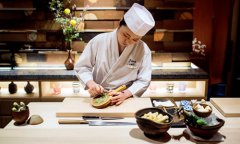
Enlarge this image
Korean food is "more vegetable-heavy than people realize, especially at home," says Eric Kim in his book Korean American: Food That Tastes Like Home. Kim's book features recipes like Grilled Trumpet Mushrooms with Ssamjang. All photos reprinted from Korean American. Copyright © 2022 Eric Kim. Photographs copyright ©2022 Jenny Huang. Published by Clarkson Potter, an imprint of Random House. hide caption
toggle caption All photos reprinted from Korean American. Copyright © 2022 Eric Kim. Photographs copyright ©2022 Jenny Huang. Published by Clarkson Potter, an imprint of Random House.
Korean food is "more vegetable-heavy than people realize, especially at home," says Eric Kim in his book Korean American: Food That Tastes Like Home. Kim's book features recipes like Grilled Trumpet Mushrooms with Ssamjang.
All photos reprinted from Korean American. Copyright © 2022 Eric Kim. Photographs copyright ©2022 Jenny Huang. Published by Clarkson Potter, an imprint of Random House.I have eaten Korean food for my entire life, but it wasn't until the pandemic forced me to move back in with my mom that I actually learned how to cook the food I had grown up with — a way that many Korean Americans (and Koreans in America) end up reconnecting with their heritage.
"The dishes that many of us grew up with are the Korean [foods] that came over in the '80s," says Eric Kim, a cooking columnist at The New York Times. "That is why I think [in] the Korean American community, there is this staunch desire to preserve all."

Eric Kim with his mom, Jean, as a child. Reprinted from Korean American, published by Clarkson Potter, an imprint of Random House hide caption
toggle caption Reprinted from Korean American, published by Clarkson Potter, an imprint of Random HouseKim is also the author of Korean American: Food That Tastes Like Home, which he wrote with his mom, Jean, when he also returned home to Atlanta during the pandemic. Kim says his book does not try to define Korean or American cooking but instead creates a – or mixed identity – cuisine. "This book documents the discovery of my Korean American-ness and my attempts and my failed attempts to define it," he says. "Because what I really believe is that our experiences as Korean Americans are so multiple and so vast that any attempt to define it is going to dilute it."
Whether you are a fellow Korean American who craves the taste of home or you are interested in exploring a new cuisine, Kim and I will walk you through pantry essentials and simple recipes to welcome more Korean flavors into your own home.
(See two of Kim's recipes from Korean American — Jean's Perfect Jar of Kimchi and )

Eric Kim is a food writer for The New York Times and the author Korean American: Food That Tastes Like Home. Left: Jenny Huang/Clarkson Potter; Right: Clarkson Potter an imprint of Random House hide caption
toggle caption Left: Jenny Huang/Clarkson Potter; Right: Clarkson Potter an imprint of Random House Build your Korean pantry – try tasting and cooking with different jangsThe first and most essential step in exploring Korean American cooking is to build a solid foundation by investing in key Korean pantry ingredients.
Kim starts with the three jangs, or fermented pastes and sauces. Jangs, like other fermented Korean foods like kimchi (a popular side dish of pickled vegetables like napa cabbage), are meant to withstand both humid summers and long winters in Korea.
Doenjang: If you are new to Korean flavors, Kim recommends starting with doenjang, or soybean paste. Doenjang is commonly used in doenjang jjigae, a stew that is often cooked with either beef or pork, tofu and zucchini. But Kim suggests experimenting with it, too: you can keep a tub in your kitchen to encourage a little dish mixology – try making glazes for fish or some homemade salad dressing.









